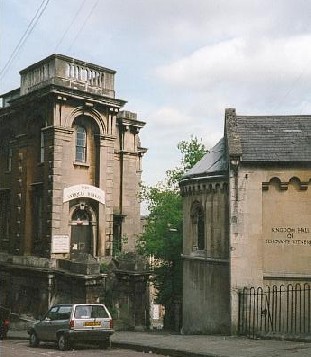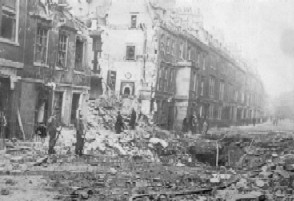|
|
|
| Home | Roman Bath | Dark Ages | Middle Ages | Upheaval | Georgian | Nineteenth century | Twentieth century | Twenty first century |

Right: The Jehovah Witness hall and the old school/antiques market. Behind you here is Hedgemead, once Edgemead, Park. The site of many landslides (hence 'edge', I guess) - bits of Camden Crescent fell repeatedly off this hillside until the builders admitted defeat and declared it public ground. Camden Crescent is uncomplete at one end as a result.
In the first years of the century Bath underwent more massive expansion. Oldfield Park was almost entirely constructed in this period - row after row of new terraced houses lining the steep hills above the railway lines.
Who would have lived in these houses? I am looking for exact details - original buying price, builders' names, original residents' names and occupations, and anything about the kind of lives they led in early suburbia. I am guessing that this area provided housing for many of workers at the Stothert and Pitt factory down by the river - but I could be wrong. Can you help?
The old railway ran right through Oldfield Park to Green Park Station - also previously called the Midland Railway Station, and Queen Square station. Now the line taken by the trains provides a thin, curving green area know as Linear Park.
There was also transport in the form of the trams - there was a tram depot in Cynthia road, and trams ran right up from central Bath to all the surrounding hills.
 Bath in the First World War
Bath in the First World WarBath provided a hospital for the wounded at Combe Park, with beds for around 1000 soldiers. As the war progressed the hospital overflowed into tents. A further 3000 war casualties were treated in the Royal Mineral Water Hospital. Meanwhile those able bodied soldiers were camped out on Lansdown. The picture is NOT from the first war, however - this is 1905, 9 years previously.
Right: The link between two houses on Lansdown Crescent, complete with iron plants in pots on the balustrade. Lansdown Crescent: 1789 by John Palmer. (see Building list for more dates of Bath's architecture). The 19th century eccentricWilliam Beckford, of Beckford's Tower fame, had a house on Lansdown Crescent, but wanted more privacy, so bought the houses on either side as well.....A secret path ran from behind the crescent up to the Tower, his retreat to write and admire his collection of artwork. Bath in the Blitz - the Second World War
Bath in the Blitz - the Second World WarBath was horribly damaged during the bombing raids, with the loss of 417 lives. Over 19,000 buildings were damaged, mostly in a two nights raid by German bombers in 1942.
Bombs narrowly missed the Royal Crescent on either side - and a direct hit on the Paragon killed one woman. One of Bath's few remaining medieval buildings, the Abbey Church House, was completely destroyed. The Francis Hotel in Queen Square was cut in half. Upper and Lower Bristol Roads, Oldfield Park, Manvers Street and Twerton all took damage.
After the bombings a wasteland of rubble filled the gaps between the buildings. Bath was a cultural target - along with York, Exeter and Canterbury, it suffered because of its heritage in (apparently) an attempt to destroy morale in Britain. Photographs of survivors, however, show the inevitable chirpy smile in the face of adversity, and volunteers rallying round with food, clothes, and temporary housing (including tents in Royal Victoria Park.) Amazingly, the Royal Crescent and the Abbey (surely primary targets) were untouched, but many other key buildings were demolished as a result of bomb damage.
As a rough guide to where the bombs hit - when you see sixties buildings in the centre of Bath, and wonder how on earth they got planning permission - the War is probably the reason.
TopAfter the war, Bath entered a new phase of prosperity. Its traditional trade - tourism - blossomed again, although the elegance of the past, Bath chairs (last one stopped in 1939) and the Grand Pump Room Hotel (directly opposite the Abbey, where BHS is now) were all gone.
Bed and breakfast places, with hot and cold water in all rooms - some of them boasting a Television Lounge - sprang up in and around Bath. The growing numbers of people who could afford cars meant that day trips to the country were a popular pastime. Bath's traffic problems - an issue for the past three hundred years - were not going to go away.
New developments took place - Horse Street was remodelled and the area given the more 'romantic', or at least, historic, name of Southgate, a reference to the southernmost gate of the city. A new bus station was built in Newark Street where bombs had levelled the houses. Between Charles Street and Kingsmead Square, modern housing was built, and more sprang up behind the London Road.
The suburbs continued to grow - Fairfield Park and Weston village - although their residents were just as likely to be workers in Bristol as in Bath, as Bath's industry entered decline (although Stothert and Pitt continued until 1989 - much of their site only recently occupied by the Sainsbury's development.)
TopBath was awarded the status of World Heritage Site bu UNESCO - alongside such others as Stonehenge, Easter Island and Venice - places regarded as unique on Earth for their cultural and historic significance. When you stand on the World Heritage Site symbol set in the ground outside the entrance to the Roman Baths in Stall Street, you are close to the source of the hot springs, not far from seventeenth, eighteenth, nineteenth or twentieth century buildings, and at the cultural centre of this amazing city.
| Home | Roman Bath | Dark Ages | Middle Ages | Upheaval | Georgian | Nineteenth century | Twentieth century | Twenty first century |